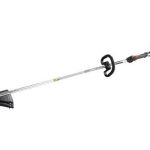Lawn care maintenance is not just something you do in the fall and spring. It is a year round job. The things you do each quarter helps to ensure that your lawn is as plush and green as you expect it to be in the fall, spring, and summer.
Let’s take a look at what you need to do in the spring.
De-thatch the Lawn
Thinning out all the dead grass and other organics that have formed in the lawn is probably the most important chore you can perform in the spring. The matter that you remove has not broken down and can therefore inhibit the lawn surface from getting nutrients and water and hamper growth.
Measure the thatch layer on the lawn. If it is thicker than a half-inch, then de-thatching is necessary. Still, experts say that even a moderate amount of de-thatching can prove beneficial.

A ruler can be used to measure how thick the thatch is on the lawn. If it is thicker than a 1/2″, then you need to de-thatch.
(Courtesy: James Wilkson)
If de-thatching is necessary, then you can do-it-yourself or hire a lawn care business to do it for you. To do the work you will need a powered or non-powered dethatching unit, which you can rent from a lawn care supplier. A tractor would be sufficient to perform the work. The de-thatcher unit uses a series of vertical discs or spring-loaded fingers to cut the rhizomes and stolons and bring them up to the lawn’s surface where it can be cleaned off.
Weed Removal
You know it’s time for weed control when the soil temperature reaches 55°F and the forsythia is blooming. Forsythia blooms at about the same time that crabgrass begins to germinate and should serve as a warning that you have several weeks to apply pre-emergent herbicide to your lawn.
A weed killer that includes chemicals like dithopyr and pendimethalin, pre-emergent herbicide prevents the crabgrass seeds from germinating. Keep in mind that it also blocks grass seed from doing the same. So if you intend to add more grass seed to the lawn, do it 6-12 weeks after you spread the herbicide.
Fertilizer
A 55° soil temperature also means that it’s time to spread nitrogen fertilizer on the lawn. Do not perform the task when the soil temperature is under 55° because there is not enough biological activity for the grass to make use of the nitrogen in the fertilizer, so the nutrients are lost to the air or groundwater.
Before applying the fertilizer, have the soil tested for its pH level. If too low, then consider adding lime. Low pH means that the soil is unable to take in the nutrients from the fertilizer. The test results will tell you how much lime to apply. The test can also tell you the proper amounts of nitrogen, phosphorous, potassium, and, sometimes, sulfur, organic matter and other types of positive substances you will need in the fertilizer. The soil test and the addition of lime, if necessary, should take place before you fertilize.
This is also a good time to create a natural, self-sustaining source of nitrogen in the lawn. You can achieve this by including clover in the seed mix and to let the grass clippings remain on the lawn after mowing. The grass clippings can offer as much as 25 percent of a lawn’s nitrogen requirements and clover naturally fastens nitrogen to the soil from the atmosphere.
Sure, you probably would rather be attending a baseball game. But consider this. The time you put into performing these chores is an investment toward the creation of a lawn you can brag about.






